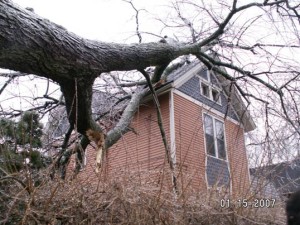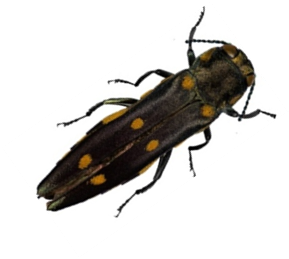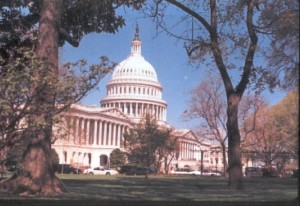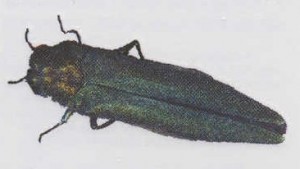Much of the attention to invasive plants has focused on herbaceous plants (forbs and grasses) invading grasslands and sagebrush steppes of the West. Certainly these plants have invaded large areas and have – in the case of “strong” invaders – caused significant changes not just in plant community composition but also to food webs and even ecosystem structure and function. Some of these invaders have imposed large costs by reducing livestock forage, fueling more frequent fires, or contributing to severe declines in populations of iconic wildlife species.
For these reasons, the House Interior and Oversight committees have held several hearings on invasive species in recent years. Much of the committees’ focus has been on invasive plants and the failure of federal land-managing agencies to curtail or reverse their spread.

Scotch broom; photo by Eric Cooms, Oregon Department of Agriculture
At the most recent hearing, Dr. George Beck of Colorado State University noted that the number of acres of land managed by the Bureau of Land Management that has been invaded by harmful non-native plants has doubled since 2009, reaching 77 million acres. Dr. Beck and his allies in the Healthy Habitats Coalition (HHC) believe that federal agencies could bring about a decline in the “weed”-infested area if they focused their resources. The HHC has persuaded members of Congress and Senators to introduce two bills (H.R 1485 & S. 2240) which would, inter alia, require land-managing agencies to allocate their invasive species funds according to the following formula: 75% for on-the-ground activity; 15% for combined research and outreach; 10% or less for administrative costs. (I discussed these proposals in my blog of January 4th.) The HHC apparently has given up trying to persuade the Congress to increase funding for land managing agencies’ resource management programs; instead, they seek to re-direct existing (shrinking) agency funds away from environmental compliance, planning, priority-setting, and research and to “on-the-ground” actions.
But I don’t think reversing plant invasions should be tackled without science and planning.
The remainder of this blog is based on the research results of Dean Pearson, USFS researcher based in Montana. See particularly the three sources listed at the end of the blog.
Studies have shown that simply suppressing the target weed does not ensure mitigation of its impacts. Managers need to weigh the success of control measures against their side effects. In the end, it is often very difficult if not impossible to restore invaded ecosystems to their pre-invasion condition. Instead, the goal of “weed” management should be to improve the system as a whole, as measured by the overall system response to management and not simply by the degree to which the target weed is suppressed. Pearson calls this “directed community assembly”.
Acting otherwise – wasting limited funds and resources on programs that don’t succeed; or – worse – that result in exacerbated ecological damage – is not acceptable! Nor is it acceptable – in my view – to be so focused on providing forage for livestock as to ignore invader- or management- induced decimation of native forbs (see below).
Pearson’s studies have focused on efforts to suppress spotted knapweed, one of the worst invaders in the grasslands of the intermountain West. Spotted knapweed invasions have both direct and indirect effects on these systems, including replacing the principal native forb (arrowleaf balsamroot); causing significant declines in invertebrates such as grasshoppers that are fed on by many small predators such as birds, small mammals, and spiders; and probably decreasing forage for domestic and wild ungulates. Invasive European forbs (including spotted knapweed) are generally larger, more rigid, and more structurally complex than the native grassland vegetation. This shift in vegetation architecture has led to a dramatic increase in native web-building spiders, resulting in an astonishing 89-fold increase in predation rates on spider prey. Knapweed invasions also apparently increase soil erosion and change the availability of soil nutrients. So, knapweed invasions have significant and persistent ecological effects. The variety of effects means that controlling spotted knapweed is likely to restore pre-invasion conditions only to the extent that native vegetation recovers. Recovery of the plant community might in turn depend on the ability to mitigate abiotic impacts of invasion, restore seed sources, and address similar factors that may interfere with native plant recovery.
Addressing the complexity of natural systems’ responses to plant invasion is difficult, especially given the limitations of available management tools.
According to USFS researchers Dean Pearson and Yvette Ortega, to improve weed management in natural systems, we need to better understand three important factors that greatly complicate natural areas weed management. Managers need to:
1) determine the invasive plants’ impacts on species, community, and systems; and which ones may be amenable to mitigation given current tools.
2) understand how prospective management tools might cause deleterious side effects and what can be done to minimize those effects.
3) understand the ecological conditions and processes underlying secondary weed invasions so that they can develop strategies to reduce the risk of secondary invasion following target invader suppression. (Pearson & Ortega 2009)
Programs aimed at countering plant invasions – no matter the method used – can cause unwanted damage to the ecosystem (= side effects). Side effects might affect not just non-target native plants, but also higher trophic levels, community interactions, and even ecological processes structuring the system.
These side effects need to be balanced against the damage caused by the invasive plants due to the complexity of natural systems and the limited specificity of the tools employed. Some might persist for years after control of the invasive plant. Managers need to consider the effects of both the invasive plants and the management action when selecting a strategy.
Forbs commonly making up ~80% of species richness in the intermountain meadows. In some un-invaded plots in western Montana, arrowleaf balsamroot mean cover was twice that of the native grass bluebunch wheatgrass. Forbs support communities of pollinators, herbivores, and higher trophic levels. Both invasion by alien forbs such as spotted knapweed and weed control efforts using either herbicides or grazing can lead to suppression of the native forbs. Thus at the study sites, broadcast spraying of the herbicide picloram reduced arrowleaf balsamroot cover and fecundity variables by nearly 60%. In this case, knapweed control efforts actually exaggerated the trajectory of species composition change initiated by spotted knapweed invasion – even when the invader was successfully removed.
Biological control is the most selective weed management tool currently in use other than hand pulling. However, even highly host-specific biocontrol agents can have rather significant non-target effects. One example is the dramatic increase in deer mouse populations in areas where they can feed on gallflies introduced as biocontrols for knapweed. Deer mice support the hantavirus pathogen, so this represents a potential human health threat. Worst of all, the gallflies have not proved effective at reducing knapweed populations – so the invasive plant, the mice, and the virus now all thrive. (In cases when the biocontrol agent is efficacious in significantly reducing the target plant species, any undesirable side effects will also be reduced.)
Furthermore, success in suppressing invasion by one set of plants often facilitates invasion by some other plant species that might cause greater changes to the system or that are harder to control. The problem of secondary invaders is not limited to any one management strategy, target weed, or secondary invader. Pearson think secondary invasion is likely any time additional species of strong invaders are present at a site where a dominant weed is controlled and the secondary invader proves relatively insensitive to the control method.
Grasses are most often the secondary invaders (whereas most target weeds were forbs). Perhaps, at least in some cases, weed control is simply accelerating general patterns of invader succession. In their study area in western Montana, Pearson and Ortega have found that cheatgrass invasion occurred faster in herbicide treated areas, but it also occurred in both otherwise un-invaded native grasslands and untreated spotted knapweed-invaded sites.
Secondary invasion by cheatgrass might be a particularly common consequence of weed control measures in western North America, given the species’ widespread occurrence, and its ability to exploit resources released by suppression of perennial taxa, outcompete native grasses, and attain dominance even when present at low initial densities (Ortega and Pearson 2010).
Pearson calls for understanding and addressing the system-level processes such as propagule pressure or disturbance underlying and promoting invasions in order to minimize secondary invasions.
In some cases, full restoration is not the manager’s goal. Managers of areas managed primarily as grazing lands might accept loss of forbs; even cheatgrass can be used as forage during part of the year. However, large scale reductions of forb diversity in grassland systems would not be acceptable in natural areas management.
While I think highly of Dr. Pearson’s studies, I think that researchers in the West pay too little attention to the contributing role of propagule availability, especially people’s role in taking propagules to sites where they can initiate invasions. Human movement of plants to satisfy wants for ornamental horticulture, or as unwise choices for erosion control or wildlife forage and shelter plants explains numerous examples of invasive forbs, shrubs, and trees proliferating across the West. However, there are also recent examples of unwise propagation of livestock forage grasses – cold-tolerant buffelgrass, anyone?
——————————–
Sources of scientific evaluations of plant management strengths and difficulties:
Yvette K. Ortega and Dean E. Pearson. 2010. Effects of Picloram Application on Community Dominants Vary With Initial Levels of Spotted Knapweed (Centaurea stoebe) Invasion. Invasive Plant Science and Management 2010 3:70–80
Pearson, D. E. and Y. K. Ortega. 2009. Managing invasive plants in natural areas: moving beyond weed control, pp 1-21, in (ed.) R.V. Kingley, Weeds: Management, Economic Impacts and Biology. Nova Publishers, NY
Ortega, Y. K., and D. E. Pearson. 2005. Strong versus weak invaders of natural plant communities: assessing invasibility and impact. Ecological Applications 15:651-661.
Posted by Faith Campbell






